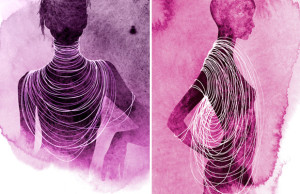Deconstructing the Mechitza

Cara Herbitter is pursuing her Masters of Public Health with a focus on sexuality at Columbia University. She has previously been published in New Voices and On Our Backs. This article has been reprinted with permission from the journal Sh’ma, as part of a larger conversation on sexuality.
 Sitting in the shul’s balcony next to my mother, I devoted significant portions of the Shabbat service trying to catch my father’s eye, waiting for his smile to acknowledge our arrival. It had been several years since I had sat in the men’s section and I missed being covered by my father’s tallit while the kohanim blessed the congregation. His smile was the closest I came to the men’s section from this side of the mechitza.
Sitting in the shul’s balcony next to my mother, I devoted significant portions of the Shabbat service trying to catch my father’s eye, waiting for his smile to acknowledge our arrival. It had been several years since I had sat in the men’s section and I missed being covered by my father’s tallit while the kohanim blessed the congregation. His smile was the closest I came to the men’s section from this side of the mechitza.
After high school, I spent a year in a women’s Modern Orthodox midrasha located in the Old City. We’d often go to the kotel on Friday night to pray. The men’s section was noticeably larger and more spirited than the women’s side, where many women prayed fervently but always by themselves. On the occasions when we had a large enough group, the women in my school would sing and dance proudly, celebrating our love of Shabbat.
One particular week, a woman came over to me and said that our behavior was inappropriate for such a holy place. Drawing upon the strength of the rebellious women around me, I returned, “this is exactly the place for our singing and dancing.”
The feminist critique of the almost exclusive leadership role of men in Orthodox services has been addressed in some congregations that maintain a mechitza. However, in college, my feminist struggles were compounded by a newfound commitment to queer politics. While praying in the absence of a mechitza, I began thinking about its role in constructing heterosexuality as the norm and gender as a binary system.
Of the myriad explanations I’ve heard, the dominant one is as follows: a mechitza helps men and women remain undistracted by one another. Sometimes this is explicitly gendered, that is, men especially have to be protected from women because their “greater sexual desire” might distract them from their spiritual pursuits. Interestingly, the mechitza, by dividing men and women, may serve to heighten sexual tension as people take peeks at each other across the divide, which is perhaps another way of inscribing heterosexuality.
Ironically, the mechitza has an additional and unintended possibility: the potential to create a homoerotic area as men or women flirt within their cordoned space. While this subversive space exists, it does not excuse the underlying heteronormative intentions of the mechitza. Beyond sexual orientation, the mechitza limits gender expression and explicitly excludes a segment of the transgender community — namely those who don’t identify as either male or female.
During my junior year of college, a student decided to organize a special Orthodox Shabbat service replete with a mechitza and Modern Orthodox men imported from New York to lead our service. Unfamiliar with my background, she invited me to “experience the mechitza.” Unexpectedly, I found myself so uncomfortable that I left midway through the service. I felt as if my safe space had been invaded — the mechitza running through me signaling a conflict between supporting pluralism and upholding my commitment to queer politics.
The practice of mechitza must be reconsidered. It is not simply a neutral practice that upholds traditional halakha; rather it upholds discriminatory norms that limit our sexual and gender expression from reaching their full potential. Borrowing from the language of that woman years ago at the kotel, these are the things that truly do not belong in this holy place.













2 Comments